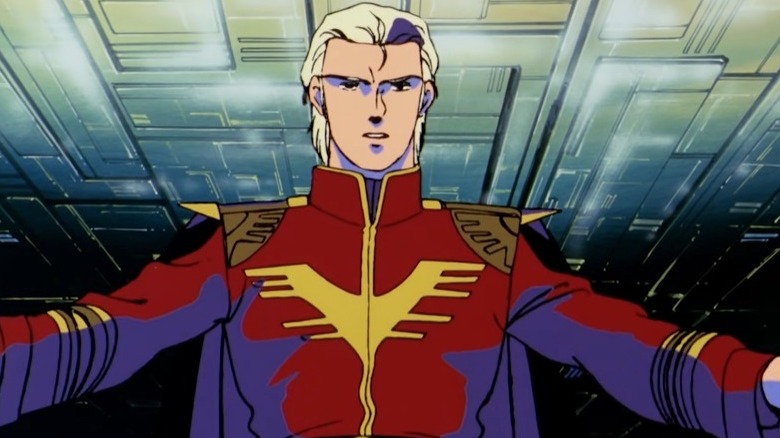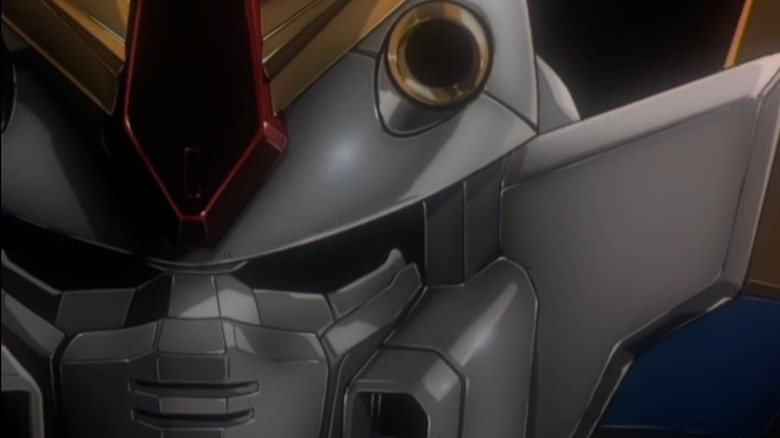The Correct Order In Which To Watch The Gundam Franchise
For many anime fans, the mere mention of the mecha genre quickly brings to mind the "Gundam" franchise. For multiple decades, "Gundam" has not only popularized the mecha genre but set itself as quite the commercial juggernaut with an impressive cavalcade of toys, video games, and numerous anime series and films. And the franchise is showing no signs of slowing down, as there is both a new "Gundam" anime series in development and a live-action film through Netflix.
"Gundam" is a worthy property to experience for anyone looking for deep stories about young people forced into the horrors of war, or simply cool-looking mecha battling each other. But there's a staggering amount of content within the franchise, and some curious viewers may not even know where to begin or continue. Tackling the entire "Gundam" Franchise might seem about as gargantuan as the height of the real walking Gundam in Yokohama (via People Magazine). But with a bit of research, and probably a clear calendar, it's definitely possible. Fortunately, we've got the first part covered. While you could watch everything simply by order of release date, it's more interesting to follow the story in a more logical path. With that said, let's take a deep space dive into the best order to watch the "Gundam" franchise.
Start with Gundam Origin (2015) and Mobile Suit Gundam (1979)
The main idea to keep in mind with the "Gundam" franchise is that its main canon timeline is called the Universal Century (UC). Started by series creator Yoshiyuki Tomino, the early part of the timeline mostly deals with the conflict between the Principality of Zeon and the Earth Federation. Most viewers could start their "Gundam" journey with the first "Mobile Suit Gundam" which kicked off the entire franchise upon its 1979 release. But for curious first-time viewers, it's an excellent idea to instead start off with the six-part OVA 2015 series "Gundam Origin." The OVA details the origins of the war and the story of the influential rival, Char Aznable. And due to the limited animation of "Mobile Suit Gundam," "Gundam Origin" is a perfect way to ease in anyone new to the UC. Starting with both series introduces us to the world of Gundam and more importantly the iconic rivalry between Gundam Ace Amuro Ray and the "Red Comet" Char.
Next, we enter "Mobile Suit Zeta Gundam" and "Mobile Suit ZZ Gundam," which are set seven years after the events of the first series. They not only continue the conflict between Earth Federation and various Zeon rebels but also still feature the rivalry between Amuro and Char. Their conflict comes to its thrilling conclusion in the 1988 movie "Char's Counterattack" which canonically follows the two "Zeta" series.
Hathaway (2021) continues the UC timeline while Turn A (1999) kind of concludes it
With Amuro and Char's story wrapped up by now, the UC continues to blast through. The characters change, but space mecha war, well, that never changes. Chronologically, the next primary follow-up to "Char's Counterattack" is "Mobile Suit Gundam Unicorn" and its direct sequel film, "Gundam Narrative." Released in 2010, "Gundam Unicorn" marked a return to the UC timeline after the franchise had spent two decades with alternative timeline-based series. It's set three years after "Char's Counterattack." Next is the Netflix 2021 release of "Mobile Suit Gundam: Hathaway," which is set 12 years after "Char's Counterattack." Starring a protagonist named Hathaway who is influenced by the ideologies of both Amuro and Char, the newest entry in the "Gundam" franchise is the first part of a planned trilogy (via ComicBook.com).
We start to see the franchise move the UC further with the 1991 film "Gundam F91." The film is set 30 years after "Char's Counterattack" and is full of beautiful animation. However, what follows that movie is perhaps one of the most controversial series in the franchise: "Mobile Suit Victory Gundam." The series, which came out in 1993, is notorious thanks to nearly every episode killing off a character (via Sojapan). Fortunately, the end of the UC timeline receives a positive sendoff thanks to "Turn A Gundam." Released in 1999, the series is set 2000 years after the UC timeline. With its unique Gundam designs, bright animation, and familiar central theme of space conflict, the series feels like a celebration of the entire franchise. That might be intentional, as Gundam creator Yoshiyuki Tomino once said in an interview with Anime News Network that "Regarding 'Turn A Gundam,' I made it with the idea of affirmatively accepting all of the Gundam series."
There's no incorrect way to watch UC side stories or explore the multiverse
We might have reached the finish line when it comes to UC-centric content, but we've still got some victory laps to take in the form of supplementary series. What's great is that most of these side series offer a glimpse of what was going on during the One Year War without having Amuro and Char in the spotlight. Also, they can be watched in just about any order at this point. "MS Igloo" offers a brief look at some of the other events during the war, while the sublime "08th MS Team" trades in space battles for a grounded clash in the jungle. "War In The Pocket" gives a unique perspective of the brutal war from the eyes of a civilian kid, while "0083 Stardust Memory" bridges some of the original "Mobile Suit Gundam" and "Mobile Suit Zeta Gundam."
There's also no wrong way to approach the rest of the "Gundam" multiverse either. We can think of these shows as various ways for the franchise to reinvent itself over time and take daring chances (via Right Stuf Anime). At this point, it's a matter of personal taste. Are we in the mood for "Street Fighter II" but with Gundam? Give the fun "Mobile Fighter G Gundam" a try. Does the core idea of young soldiers thrown into a war still sound intriguing but could benefit from some designs different from "Mobile Suit Gundam?" Then, "Mobile Suit Gundam Wing," "Mobile Suit Gundam: Iron-Blooded Orphans," or "Mobile Suit Gundam SEED" might be the answer. Heck, "Gundam Build Fighters" is perfect for fans strictly into "Gundam" model kits. Think of the multiverse as a fun buffet with giant lightsabers.



